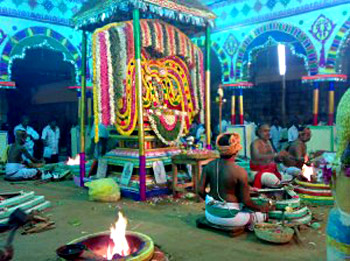 Kumbabhishekam is a temple ritual of South India. It is also known as Samprokshanam. Generally, the South Indian people are seen chanting prayers and pouring water on the top of the vimana and the gopuras of the temples with temporary scaffoldings erected within and immediately outside.
Kumbabhishekam is a temple ritual of South India. It is also known as Samprokshanam. Generally, the South Indian people are seen chanting prayers and pouring water on the top of the vimana and the gopuras of the temples with temporary scaffoldings erected within and immediately outside.
Kumbabhishekam is a Sanskrit word, which is derived from two separate words `kumbha` meaning pot and `abhisekam` meaning anointment. It is a very intricate and thorough religious ceremony and a newly constructed shrine is considered fit for worship only after the numerous rituals associated with it are completed. Kumbabhishekam or Mahakumbabhishekam is used for the sanctification of Siva temples and Samprokshanam or Mahasamprokshanam is the term used with reference to the sanctification of Vishnu shrines.
The temples are a place where the images and the surroundings should radiate spiritual energy and should look exquisite. This is possible only after the kumbabhishekam or the samprokshanam is performed in the temple. Only the highly experienced priests can perform this ritual. The priest must go through years of training and have a thorough knowledge of the rites and rituals to be performed according to the codes prescribed in the religious texts called the Agamas.
The Kumbabhishekam ritual is performed on an auspicious date and time according to detailed astronomical calculations. This ritual continues for several days so it is not possible to discuss all the minute details. The ritual involves the puja and homa for the `Vastu purusha`, the deity presiding over the site where the shrine is to be constructed. Thereafter, the ritual continues with the chanting of appropriate Vedic mantras and homas are homas are also performed in the several homa kundasin. A large number of pots (kalasha) are required to place in front of the vatgasalasm. These pots contain holy water covered with mango leaves with a coconut kept in the centre entwined on the outside with a piece of thread. The water in these pots is considered to have attained effectiveness as a result of the yogas and the mantras, which have been chanted.
The Kumbabhishekam ritual includes one more ceremony named `netronmilana` or `nayanomilana` (opening of the eyes). This is performed to enshrine the principal image of the temple. The yantra (a sheet of copper or gold with occult diagrams) is placed in the centre of the sanctum. It is one of the important and vital elements of every temple along with precious gems. The next ritual is the `Ashtabandha`. In this ritual, the yantra is smeared with a special paste made out of eight (ashta) ingredients such as powered conch, lac, whitestone, etc. mixed with butter or oil. Then the stone icon (vigraha) is placed on it. Then the prana-pratishta or the ceremony for infusing life into the image is performed.
Thereafter, as all the required pujas and yajnas are completed, the priests carry the pots around the temple enclosures (prakaras) and then pour the water over the image. This is the actual kumbabbishekha or consecration. After this, the image of the temple becomes a deity and fit for worship. The priests then offer the necessary oblations to the deity. The holy water is also poured over the vimana kalasas above the sanctum and over the gopura kalasbas by priests standing on the scaffolding erected specifically for this purpose. Similarly, they perform pujas of the goddess in the temple and also of the other minor deities installed in the smaller sanctums within the temple campus. The Kumbabbishekam ritual is performed in newly constructed temples and also for those shrines which are already in use, some hundreds of years old, in South India.
The Kumbabhishekam ritual should be performed once in twelve years as per the rules of the Shastras. But, as it involves lengthy celebration as well as very expensive and need much preparation, the ritual takes place with much longer time gap. In Southern part of India, the devotees consider it a great and rare blessing to witness a kumbabhishekam or samprokshanam ceremony.











